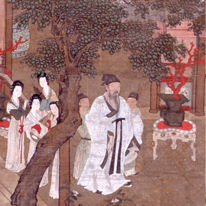Past Exhibitions
- Ming and Qing Paintings in Kyoto
- October 15, 2014 - November 16, 2014
Landscapes with dynamic compositions and new styles of literati painting were among the Ming and Qing paintings brought into Japan after the earlier import of Song and Yuan examples. These works influenced Japanese paintings of the Muromachi and Edo periods, such as the kanga (Chinese-themed painting) of the Kanō school and the Nanga (literati painting) popular in Edo and Kyoto painting circles.
Later, beginning in the Meiji (1868–1912) and Taishō (1912–1926) periods, numerous masterworks by the Four Wangs, Wu Li (c. 1632–1718), and Yun Shouping (1633–1690) found their way into the private collections of industrialists based in the Kansai area. Behind this phenomenon was the fact that the collectors were maintaining close relationships with the erudite Sinologists Luo Zhenyu (1866–1940), Nagao Uzan (1864–1942) and Naitō Konan (1866–1934), all of whom lived in Kyoto.













